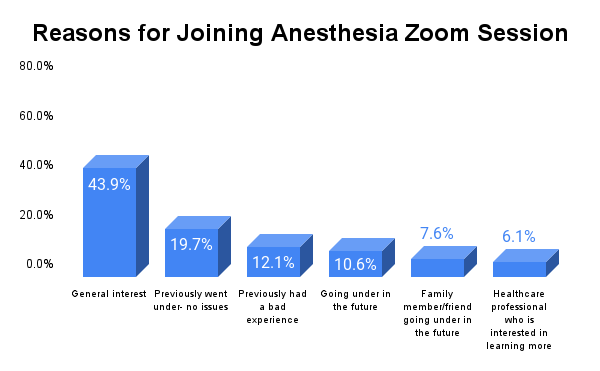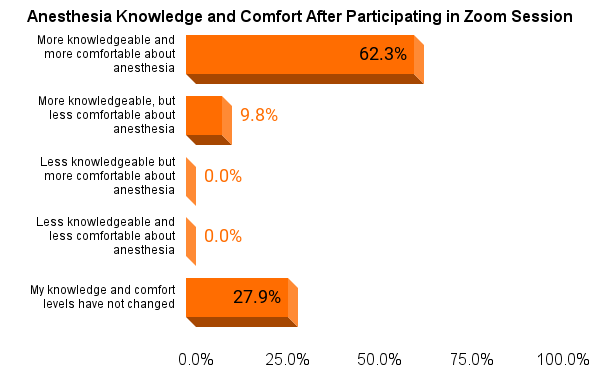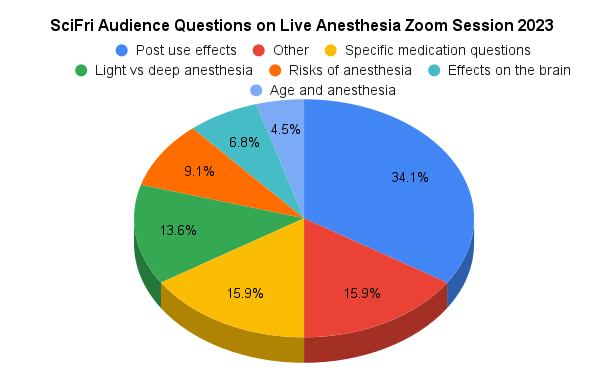What Do Two Anesthesiologists Do For The Fears Of A General Audience?
Using an Ask-An-Expert model leads to increased knowledge and comfort levels on anesthesia for audiences.

SciFri Findings is a series that explores how we understand the impact of science journalism, media and programming on our audiences. Sign up for our newsletter to get the latest reports!
Anesthesia is a word that can bring on anxiety for a number of people. For many, the procedure of how anesthesia works on patients is often misunderstood. Others have heard horror stories from friends and families about recovery from anesthesia or worse, what has happened to them while “being under.” Science Friday’s Radio Producer, Shoshannah Bauxbaum, and Manager of Experiences, Diana Plasker, had a challenge on their hands: how do they educate audiences about anesthesia while also alleviating their fears?
Science Friday has used Zoom call-in sessions in the past because they can direct buy-in from audience members. Audiences could contribute to the conversations during the Ask-An-Expert in multiple ways: ask questions “on air” during the session, in the session chat, and prior to the session during registration. We wanted audiences to have the opportunity to share both their questions and fears during the session.
The conversation was hosted by John Dankosky, Science Friday Director of News and Audio, in April 2023 with guest experts Dr. Louise Sun, a professor of Anesthesiology, Preoperative, and Pain Medicine, at Stanford University Health and Dr. Gunisha Kaur, an anesthesiologist, director of the Human Rights Impact Lab, and Medical Director of the Weill Cornell Center for Human Rights at Weill Cornell Medicine.
Caption: Science Friday live Ask-An-Expert anesthesia Zoom session held in April 2023
Recruitment for the Zoom session included posts on social media, the Science Friday events newsletter, creation of Facebook events page, and Facebook ads. More than two-thirds of registrants (67.4%) came from the events newsletter, 17.4% from Facebook ads, 9.2% Facebook event page, 2.7% Twitter, and 1.1% from Facebook posts. A total of 191 people registered for the session and 112 attended.
It was interesting to note that almost one-third (30.9%) of all registrants were new to Science Friday events. Facebook ads were the most successful way of recruiting new event audiences, with 47.5% of new audience registrations coming from the ads. We may consider increasing the use of Facebook ads to reach beyond our regular audiences in the future.
Our main goal for this Zoom session was to increase knowledge and comfort levels regarding anesthesia use. In order to assess progress towards these goals, we polled the audience during the session and captured questions asked by participants. The first poll question was “Why are you joining us today?” and included the following options: “General interest in learning more about anesthesia,” “I previously went under anesthesia with no issues,” “I previously had a bad experience with anesthesia,” “I will go under anesthesia in the future,” “A family member/friend will go under anesthesia in the future,” and “Healthcare professional who is interested in learning more about anesthesia.” This question allowed us to understand the motivations of participants and whether they were coming into the session with some anxieties already.
Towards the end of the Zoom session we asked a second poll question asking how participants felt about anesthesia after participating in the Zoom call-in, compared to before. Lastly, we conducted qualitative analysis after the session was over and grouped together the questions that the audience members asked on the Zoom by theme. Reviewing audience questions that were asked during the event helped identify the gaps in knowledge that attendees may have had.
We used a Zoom poll to ask the reason for attending the session at the start of the event. Most participants had a general interest in learning more about anesthesia (43.9%), followed by previously had both neutral (19.7%) and bad experiences (12.1%) with anesthesia, anticipated anesthesia use in the future (10.6%), anticipated a friend/family member needing anesthesia in the future (7.6%), and healthcare professionals who wanted more learning on anesthesia (6.1%). The poll allowed for only one choice, an “other” option was not available. This information helped us navigate the kinds of questions asked and how the conversation should flow.

The main goals of the sessions were to increase knowledge and comfort level on anesthesia use. Using another poll question, at the end of the Zoom session we asked the audience how they felt about anesthesia after participating on the call-in compared to before the session.

We were delighted to see that the vast majority of participants increased both their knowledge and comfort levels regarding anesthesia (62.3%). There was an additional 9.8% increased their knowledge but felt less comfortable with anesthesia (See Figure 2 above). Approximately one-quarter (27.9%) of participants stated that their knowledge and comfort levels did not change after attending the session. No participants had less knowledge after attending the Zoom session.
Science Friday audiences had a wide range of questions regarding anesthesia. Over the course of the hour-long event, 44 questions were asked (see Figure 3 below). It was interesting to note that more than one-third (34.1%) of questions were about post—use effects of anesthesia. Areas of interest also included questions on specific medications, e.g. Propofol (15.9%), light vs. deep anesthesia (13.6%), risks of anesthesia (9.1%), effects on the brain (6.8%), and age and anesthesia (4.5%). Approximately fifteen percent of questions fell under the category of “other”, which included questions like: “how do animals and humans handle anesthesia differently,” “the link between genetics and anesthesia effectiveness,” and “differences between anesthesia and sleep.” The Zoom questions and chat indicated audiences wanted practical information in order to be prepared to discuss anesthesia risks with healthcare professionals.

Our goal with this project was to increase learning and alleviate fears for audiences around a widely known, but often misunderstood, health procedure. Using the Ask-An-Expert model, we provided multiple opportunities for audiences to submit questions because we wanted multiple touch points for audiences to participate in the conversation.
By allowing audiences direct access to experts, Science Friday works to create a safe space for attendees to feel comfortable asking all of their questions freely. Making space for audience questions and experiences bridges the conversation from audiences to experts through a close roundtable discussion, and we hope this can lead to increased accessibility of science and health.
The model may be effective because we believe sharing concerns and phobias with others can build community trust amongst audience members. By building audience engagement into recording events we create more meaningful change and build community with our audiences.
Nahima Ahmed was Science Friday’s Manager of Impact Strategy. She is a researcher who loves to cook curry, discuss identity, and helped the team understand how stories can shape audiences’ access to and interest in science.